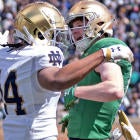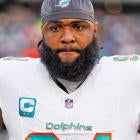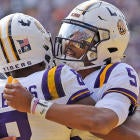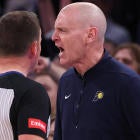One of the great things about the past decade or so in sports coverage has been the rise of some fresh voices that have come from outside the mainstream. Spencer Hall was the first writer with a grassroots background I noticed breaking through in the college football world, but it’s really been refreshing to see many others getting a foothold in their own unique way. Chris B. Brown, the brains behind SmartFootball.com, also has made a name for himself thanks to the work he does exploring the X's and O's world. If you haven’t been to his site, I encourage you to click over to it. The 20-something Kentucky native’s real job is as an attorney, but it’s obvious that his writing has become more than just a hobby to him.
This month, Chris published a book, The Essential Smart Football, a good read that has insight into not only what makes some of the top coaches in both college and NFL so successful but anecdotes and observations into their personas. This week, I caught up with Chris to talk about his book, how much time he spends trying to gain insight into these schemes as well as which head coach he’d most like to have drinks with.
BF: You've had a lot of success with your site. What made you decide to do a book?
CB: A confluence of factors. One was that I'm frequently asked what would be a good introductory book for an interested fan who wants to learn more about the game, and another is that I've been writing about football in one form or another for over six years, maybe seven. Over that time we've seen a lot of change in the game's trends and strategies, while at the same time certain principles and themes have stayed constant. I wanted to put together a relatively concise work that would cover as much of this territory as possible, while capturing the stories and context for what has driven that change and strengthened those timeless principles. I'm happy to say that the response so far has been humbling. The Essential Smart Football has spent most of the last two weeks as the No. 1 bestselling football book and a top No. 5 overall sports book on Amazon (though being released in May probably reduced my competition).
BF: One of the most insightful X's and O's pieces I've ever read ran on your site a few years ago when Mike Kuchar broke down what makes Boise State's offense such a headache for rival defenses. [Full disclosure: Kuchar, a former college player and assistant-turned-high school coach, is a friend of mine.] I know how much time he spent talking to coaches for that piece. Explain the process of how you go about gaining insight into a scheme or a coach's success. For instance, you have a chapter on Nick Saban. Can you walk me through how you can get comfortable with the intel what he does now?
CB: It depends on the piece, the scheme and my prior familiarity with what the coaches do. In general I try to approach studying a team or coach's scheme by treating it as if I was an opposing coach. This means the first place I go is to get the source materials, which for football means the game film. As you know well, you can ask questions of coaches and not get straight answers, but the tape never (or rarely, anyway) lies. This was one of the reasons Mike's piece on Boise was so good and so fun: The piece was about Boise State, but the coaches he spent time with were not Boise's coaches, but were instead coaches on Virginia Tech's staff who, from the outside looking in, had spent an offseason trying to decipher and understand Boise's myriad offensive scheme, and that's essentially where I always begin.
Buttressing that are the coaching contacts I have around various levels of football. Sometimes these are opposing coaches (though they don't like me revealing identities), some are high school or small college guys who've been to clinics, and sometimes it's just a matter of believing what the coach themselves have said, whether it is to me in clinic talks or DVDs or in other materials they've put together.
For Saban's schemes, it was a combination of all of the above. I have studied countless hours of his defenses at Michigan State, LSU, the Miami Dolphins and now Alabama, I've spoken to guys who have been fortunate enough to get nuggets of wisdom from him or have simply spent the hard time preparing for one of his vicious defenses, and rounding it out on my desk are stacks of materials about his defenses -- hours of DVDs of clinic talks, installation manuals, and so on.
Of course it's a balance and requires judgment. A big reason I like focusing on what's out there is not only do I think that is what matters -- what's important about Saban's scheme is what his opponents think about when trying to prepare for him -- but also because I never want to give away anything they would consider a "trade secret." I shy away from using team specific terminology or signals, both because I don't think they are that interesting and that is the type of information that actually could be used against a team. And it also depends on the audience. There's not a coach on Nick Saban's schedule that doesn't know he uses a lot of Cover 1 "Robber" or the types of pattern match zone schemes I describe in the book, but describing that stuff is still of great value because it's the type of thing most fans don't understand and the specific schemes and techniques are a big part of what makes his defenses so good. So bridging that kind of knowledge is, for me, the goal: To enlighten the general public about what a coach or team does without giving away any proprietary information.
BF: In your book, you hit on schemes from all across the spectrum. What has been the most complicated scheme you feel like you've taken the most time to truly get a good feel for and why?
CB: My background in my playing and coaches days was on offense, and offensive stuff still tends to resonate with me a bit better than defensive schemes. But I have had some good teachers in recent years, and have spent substantial time trying to learn some of the more nuanced ins and outs of various college and NFL defensive schemes in order to explain them. In that way, one of my favorite pieces was one included in the book on how Bill Belichick combines a 4-3 "one-gapping" defense with a 3-4 "two-gapping" defense, all on the same play, by running one to one side and one to the other, with big former Miami Hurricane Vince Wilfork manning the nose guard. Note that Saban, a Belichick disciple, uses this same hybrid scheme at Alabama.
To explain that, as well as to put it in the context of a long evolution of defensive schemes from attempts to defend the old T formation and through Jimmy Johnson's Miami 4-3, took several long conversations with coaches who'd seen those changes first hand, in addition to my notes on Belichick's specific schemes. A version of that article originally ran on Grantland before the Super Bowl, and I got one of the best compliments you can get when I ran into Vince Wilfork and his wife, Bianca, at the Kentucky Derby: Vince (who was maybe biased since the theme of the article was how good he is, and of course he's a smart guy, so he may have been just flattering me) said it was the best football article he'd ever read.
BF: Who has been the most receptive big-name coach to share information with you, and how'd that come about?
CB: Well, to be fair the guys who end up sharing the most information with me tend to do it with the caveat that I don't talk about them so much. But let's just say that in the last week I sent several complimentary signed copies of the book to various SEC coaches in the last week.
BF: How often do you hear a game analyst on TV in the middle of telecast say something where you're convinced they're off-base about the system they're talking about and does what they say, knowing that those guys often spend time with coaches and coordinators right before a game, impact how you look at something?
CB: Sometimes. It obviously depends on the quality of the game analyst and my familiarity with the underlying system. I can't speak for all TV guys but most of them are looking for a general familiarity with each coach's approach and some nuggets that will be usable on-air, and not everything can be reduced to soundbites. Everyone too has their areas of competence, including me. If Chris Spielman points out something about how a team is using their linebackers vs. some particular scheme, I'm deferring to Chris Spielman on that one. If a former NFL quarterback with no option experience is trying to describe something that Paul Johnson is doing at Georgia Tech in his flexbone triple-option system, and it sounds completely wrong to me, I'm more than likely going to point out my conflicting view. In general, announcers are getting better each year, but for example, when the spread offense first burst onto the scene, announcers constantly butchered play descriptions. Now that the spread is no longer such a new thing, basic mistakes like that been reduced.
BF: With the success Chip Kelly has had and the impact Chad Morris had at Clemson, we've heard a lot more about college offenses trying to go more up-tempo now. Going forward, what do you predict will be a scheme or tweak that someone does now that isn't very common but is going to be talked about much more in 2012 and 2013 is:
CB: On offense, I think what you will see a ton of is the increased use of "packaged concepts" where runs and pass plays and screens are all combined into one single playcall. This follows from the up-tempo no-huddle offenses, as those offenses thrive when the playcalls are simple and the offense can run up and simply execute. And we've seen similar ideas with bubble and other quick screens combined with run plays. But, led by what Dana Holgorsen did at Oklahoma State and Mike Gundy and Todd Monken extended this past season, you're going to increasingly see these packaged concepts on Saturdays, as these new plays combine downfield passes with runs, or even a downfield pass to one side, a screen to the other and a run up the middle.
For example, at Oklahoma State last year, Monken, Brandon Weeden, and Justin Blackmon killed people and just marching up and down the field calling the same concept over and over, one where where Weeden was given three options: 1) throw a slant or fade downfield to Blackmon who was singled up one-on-one, 2) throw a screen to the opposite if the defense didn't put enough defenders there, or 3) hand it off up the middle to Joseph Randle. And no matter what Weeden chose, the other players always did their single task: Blackmon ran his route, the other receivers ran the screen, and the offensive line always blocked the run play; it was one-call and go. As last season went on, other teams began using these ideas too, including in the Green Bay Packers in the NFL. And just a few weeks ago new Notre Dame offensive coordinator Chuck Martin described during their spring coaches clinic plans to use these same concepts. This is all new territory for playcalling; instead of choosing between a run or a pass, why not both, at a warp-speed no-huddle, and let the quarterback decide based on the defense?
BF: If you had the chance to go become a graduate assistant for any college coach who would you want to work under and why?
CB: That's a tough one, as a coaching career can be built in a lot of ways. The rule with most jobs is to find a good work environment, which means having a boss who is a good manager is more important than what playbook they use. Thus my first recommendation would be to find someone who will take the time to help you personally develop as a coach versus only just to do the menial stuff that comes with the territory (which you'll have to do in either case).
But if you're looking for good coaches and a resume with some schemes that will stay useful, Kevin Sumlin's staff at Texas A&M is potentially a great landing spot and I've heard nothing but good things from my friends in the business. And, although he's not a head coach, if you're looking to hitch your wagon to an ascendant defensive coach Manny Diaz at Texas might be the most intriguing up-and-comer of them all.
BF: Which football coach would you most like to drink a few beers with?
CB: That's one of the great things about football coaches; most of them are pretty good at throwing back a few beers. As a group, offensive line coaches are the best because they know where the good eating spots are and can consume massive amounts without any (apparent) adverse effects. But to limit it to guys I've never actually had beers with, Sumlin, Holgorsen, and Leach are all great (if somewhat obvious) candidates. Though a day sitting on the couch, watching football, eating pizza and drinking beer with Les Miles -- "molting," to use Miles' terminology -- sounds about as good as it gets. Actually, Bruce, I'd like to ask you this same question: Who would you like to grab some beers with?
BF: Good question. I interviewed Barry Switzer for Leach's book. He’s one of the best story-tellers I’ve ever interviewed. I’ve never met him in person. I suspect he’d be a blast to have drinks with.
BF: What are the three things you're most intriguing by heading into the 2012 season?
CB: First, I'll definitely be watching for the increased use and expansion of those combination or "packaged" concepts I described above. Second, on defense the big trend I see is to take existing defenses, like the 3-4 or 4-3, but to begin using more “hybrid” defenders in the base defense, guys who were maybe considered “tweeners” a few years ago without a true position. These are the linebacker/safety hybrids and the defensive end/linebacker hybrids, who, when facing all these no-huddle or multiple-formation attacks, must be able to both take on a fullback or tight-end at the line, rush the passer, or drop into pass coverage. You're definitely starting to see it in the NFL as they need players who can stuff the run and cover athletic tight-ends down the field. But you also are increasingly seeing it in college, both given the diversity of offensive attacks from week to week -- pass-first spread to pro-style to option to run-first spread -- and the increasing speed with which they operate in the no-huddle. Defenses don't have the luxury of having time to substitute the exact personnel they want for a specific situation; they need dynamic, multi-purpose playmakers on defense to deal with dynamic, multi-purpose playmakers on offense.
Third, and more specifically, it's clear that the SEC has dominated college football for the last several years, and a lot of that has been due to their outstanding defenses. Alabama and LSU's talent-laden squads last year were, of course, Exhibit A. Yet almost all of the rest of college football has been paced by offensive juggernauts like Oregon, Stanford, Oklahoma State, and so on. Obviously whether the SEC's defense-led dominance can continue is really the most pertinent question in all of college football in terms of deciding who will be the next champion. But the complexion of the SEC itself has changed with the addition of Missouri and Texas A&M, two spread teams whose coaches have had lots of success on offense in the past, along with the up-tempo spread offense new coach Hugh Freeze is bringing to Ole Miss. All of those teams have weaknesses -- A&M appears to be the most talented, but we don't know if they have a quarterback -- so I'd be shocked if any of them actually won the SEC over the favorites. But it will be fascinating to see what kind of success, if any, they have this fall. And it will be even more fascinating to decipher whether that success or failure portends any changes, one way or the other, for the rest of college football.



















